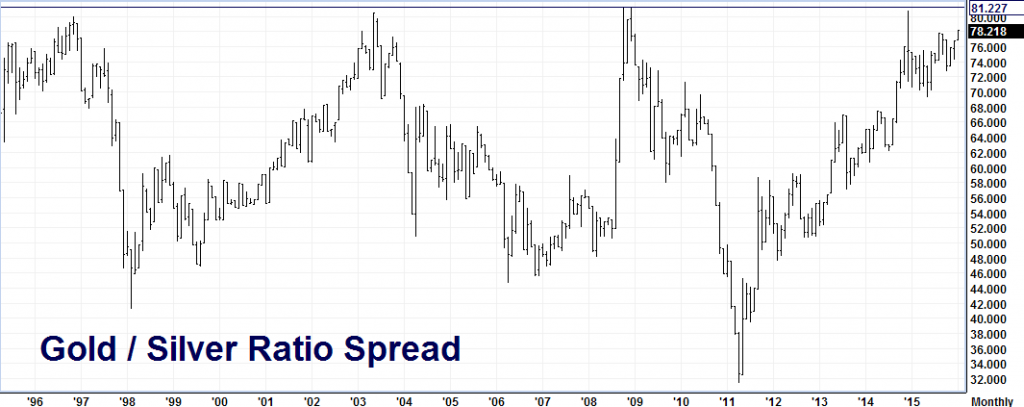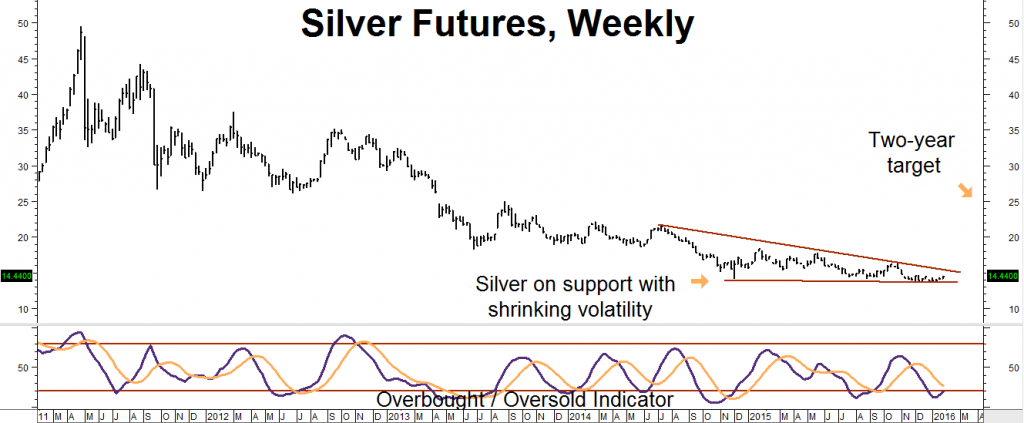“Hit em’ where they ain’t.” This phrase was made famous by baseball Hall of Famer and batting champ Willie Keeler who was known to surprise opponents by doing the unexpected – batting and bunting in unusual ways to get on base. It is also the perfect encapsulation of what we are thinking in silver right now.
Very few analysts expect silver or any other commodity to do much of anything as long as the Fed remains in tightening mode and the dollar stays strong. Continued Fed tightening and a stronger dollar are deeply held consensus views that are already reflected in prices. Unloved and abandoned, the poor man’s gold is getting no respect and even less attention. Silver is definitely the market “where they ain’t” right now.
Central Banks are “Out of Bullets”
The global economy is entering a critical juncture in the ongoing war between inflation and deflation – one that deflation appears to be winning handily despite nearly a decade of central bank money printing and zero interest rates. Zero interest rates in most developed economies mean the central banks of most of the world’s economic powers are “out of bullets” in the traditional sense. December’s rate increase off of zero by Janet Yellen and the Fed was an attempt to “reload” the gun for the US.
It’s not going very well. Stock markets both here and across the globe have responded to the Fed’s move with a huge Bronx cheer. The economy as a whole hasn’t responded much better as witnessed by yesterday’s pathetic 5.1% drop in Durable Goods orders and this morning’s anemic .7% growth in GDP. Unless things improve, the Fed will be forced to fire the bullet it just chambered, which is also its only bullet left.
Why did the Fed risk raising interest rates at a time of so much uncertainty? Because it knew that the only potentially effective weapons left to fight deflation in a world of zero interest rates are negative interest rates – something that EU countries, including Germany and Switzerland, have already employed. You can add Japan to that group as of this morning. Negative interest rates impose a “tax” on safety – something Janet Yellen wants to avoid here in the US if she can.
Want to make sure your money is safe by parking it in a bank or government bonds? It’s going to cost you in a growing number of nations. Central banks hope negative rates will discourage investors from playing it safe and instead, encourage them to invest their cash in the “real” economy. Central banks are run by economists who assume people make rational decisions. They forget that humans are wired by evolution first and foremost for fear.
Negative rates send a signal that things are bad and could in fact get worse. Safety quickly becomes something that investors are actually willing to pay for – defeating the whole purpose of negative rates in the first place and forcing central banks to make them get even more negative to achieve the desired effect.
Silver and Gold in an Era of Negative Interest Rates
We could go on and on about how the fractional reserve banking system that the entire world relies on can be reasonably be seen as nothing more than a sanctioned Ponzi scheme and how inflation is essential to the working of that scheme — which is why virtually ALL of the globe’s central bankers are desperately craving inflation right now. But our topic today is silver. We mention central banks because negative interest rates could be good, and perhaps even very good, for both silver and its richer cousin, gold.
Precious metals like silver and gold have been associated with money since the dawn of history. Some people belief they actually ARE money. (We are not going to jump into that minefield – not today at least.) However, one of the big knocks on silver and gold is that it pays no interest and therefore generates no return. Worse yet, holding physical gold and silver actually costs money in terms of storage costs, insurance, etcetera.
What happens when these disadvantages are removed by forcing similar conditions on investors looking for safe ways to store their cash? Gold and silver don’t look so bad when it costs money to leave cash in a bank or in government securities.
Depending on how high the negative interest rate premium becomes, gold and silver may turn out to be even better alternatives than cash. Have we reached that point yet? No. Are we getting closer? You bet we are. Most investors view silver and gold as hedges against inflation. However, both also tend to do well when extremely low interest rates make them reasonable alternatives to cash.
Silver May Have More Upside Potential Than Gold
One of the main reasons we like silver better than gold right now is its price relationship to the latter. Metal traders monitor this relationship using the “gold/silver ratio.” This ratio measures the amount of silver (in ounces) needed to purchase one ounce of gold. Gold is roughly 15 times rarer than silver. Back when both metals were used as actual money, their prices danced around a ratio of 16 ounces of silver to one ounce of gold. As the chart below indicates, this has changed.

Right now it costs 78 ounces of silver to buy one ounce of gold. This has been a big level of resistance going back a little over 20 years. This tells us that this relationship is getting to the point where either: 1) silver should begin outperforming gold or, 2) gold should begin underperforming silver.

The chart of silver itself (above) shows an oversold, listless market with shrinking volatility. In the spirit of Willie Keeler, we are going to try and “hit ‘em where they ain’t” by constructing a low cost long position in this forgotten commodity. Oversold and resting on multiyear support, silver may be slow and uninteresting now but we don’t believe it’s going to stay slow for much longer. In the meantime, we are also going to also try to use silver’s surprising collapse in volatility and almost universally bearish sentiment to our advantage.
Silver is known for its wild swings, making its options notoriously expensive. This market’s multi-year collapse in volatility has rendered long-dated COMEX silver call options cheaper than we’ve seen in at least a decade. At the same time, bearish sentiment has caused long-dated put options to hold a lot of their value. By combining these two conditions we can create a plan of action that can keep costs low and potential high.
What To Do Now
For our trading customers, we are recommending a long-term trade with two levels. The first and “safest” is to consider a spread position using the December 2017 COMEX call options in silver. The strategy we are recommending right now costs roughly $2,000 and has the potential to be worth as much as $25,000 should our long term target of $25 per ounce be reached on or prior to the expiration of our options on November 27, 2017. Your maximum risk on the trade is the $2,000 (or so) spent for your spread position plus transaction cost.
Why the $25 per ounce target? If represents a correction of roughly 30% of the move that took silver from its high of nearly $50.00 per ounce in 2011 to last December’s low of $13.62 per ounce. We have a little under 2 years to be right.
You can take the trade suggested above to a new level and reduce your cost to “zero” (or even less!) by adding a bit of risk. As we write, this you can cover (pay for) the entire $2,000 cost of spread trade suggested above by also selling a COMEX $10 silver put. When you sell a put you receive money in exchange for the obligation to buy silver at $10 per ounce. The money you can receive for agreeing to do this more that covers the cost of the call option position right now.
However you need to be willing and financially able to own 5,000 ounces of silver at $10 per ounce and fund a futures account with enough margin to hold a long futures position. Call your personal RMB broker if you are interested in either component of this trade. They will be happy to walk you through it and explain all the rewards and risks.
Getting Started
You need a futures account to trade the recommendations in this report. The RMB Group has been helping their clients trade futures and options since 1984 and are very familiar with long-term “Big Move Trade” strategies. Call us toll-free at 800-345-7026 or 312-373-4970 direct to learn more. We’ll send you everything you need to get started. You can also visit www.rmbgroup.com to open an account online.
If you are new to futures and options and want to learn more about them, download the “RMB Short Course in Futures and Options” – our easy-to-read guide covering all the basics. Call us toll-free at 800-345-7026 or 312-373-4970 direct or go to our website www.rmbgroup.com. Click the “Education Tools” tab at the top of the home page, scroll down to find the report and click on it.